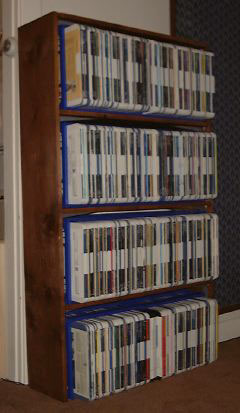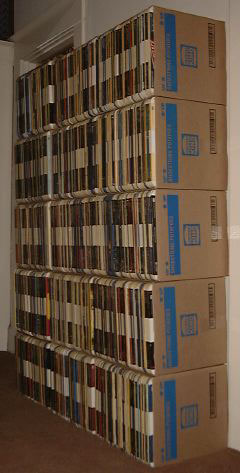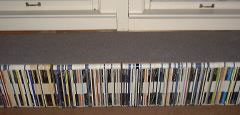
 |
Search | FAQ | US Titles | UK Titles | Memories | VaporWare | Digest | |||||||
| GuestBook | Classified | Chat | Products | Featured | Technical | Museum | ||||||||
| Downloads | Production | Fanfares | Music | Misc | Related | Contact | ||||||||
| CED Storage Options | ||||||||||||||
Several people have asked me how I store my CED collection, so I prepared this document to provide the details. Storage is an issue primarily to people who are assembling large collections of CED's. Caddies should always be stored like books in a shelf, never stored flat in a stack, as the pressure will damage the disc grooves. Using a multi-tiered bookshelf arrangement is the most space efficient, but keep in mind that this concentrates a lot of weight in a small amount of floor space. This is not a matter to be taken lightly, as I know of an instance where a large collection of CED's broke a mobile home in two, and once heard of an instance where a large aquarium fell through an apartment floor. In the case of the mobile home, there were about 1200 CED's stored at the very back end, and when the home was being moved to a different space, the dynamic load of the CED's snapped the mobile home frame when the moving truck applied its brakes.
Modern home construction requires an average minimum floor strength of 75 lbs. per square foot, which means if the floor was completely covered with a single layer of vertically stacked CED's, the floor would be at its approximate weight limit. Of course weight is seldom distributed this uniformly, so there may be large areas of empty floor space, and other areas where the weight far exceeds 75 psf. The safest place to locate CED shelves is against an outside or interior wall that extends down to solid ground, or over a vertical post anchored in solid ground. Never put a shelf in the middle of a room where there is no underlying support.

|
Wood Shelving
Pictured to the left is the type of shelving I use for most of my CED's. These shelves are constructed of solid 1 x 12 pine with four steel 8 x 10 shelf brackets supporting each level. This wood/steel construction results in a very rigid shelf that exhibits no sagging when full of CED's. The complete shelf requires a total of sixteen 8 x 10 brackets (Stanley #25-0548) and ninety-six #6 5/8" wood screws, that can usually be found in a 100/pack. I made my shelves 64" tall and 36" wide, which requires two 12' lengths of pine for one complete shelf. Never use particle board to construct CED shelving, as it simply can't bear the weight of the discs. The discs in my shelves are stored in blue collapsible storage boxes that provide a precise vertical fit for a CED caddy, but they could just as well be stacked directly on the wood shelf, with a spacer at both ends to provide clearance for the steel brackets. This printable shelf diagram provided the precise measurements for my shelves. |

|
Cardboard Box Shelving
This type of shelving is the least expensive and most space efficient as it consists of nothing more than tightly packed cardboard boxes. I got these Burger King boxes at a surplus box company for $0.60 each, so the whole shelf cost $9.00. With this type of storage the disc caddies themselves form the support structure of the shelf. You might think this would damage the ones on the bottom, but imagine taking a stack of empty caddies and taping them tightly together. The resulting lattice structure is quite rigid when oriented vertically and can support a great deal of weight. Even thought this shelf is five tiers high, it is much more stable than the pine shelving above, which had to be anchored to the wall for stability. But there are some significant disadvantages to this cardboard shelving. The fact that the disc caddies are used for support makes it difficult to get a disc out of the lower levels, and nearly impossible to put it back without damaging the label on that disc and the two adjacent ones. I wouldn't even attempt to pull a disc out without breaking the shelf down to the level occupied by the disc. This isn't too bad since the boxes in the center column can be removed while the ones on the ends are left in place. A problem could also arise if discs are removed from the lower levels and not put back. If this "needling" continues for long enough, the shelf will lose its stability and collapse to the left or right. The Burger King boxes I used are marked with the measurements 15 1/2" x 12 3/4" x 13". When going to purchase boxes, take a CED caddy along to use as a measuring device. The caddy should fit precisely inside the box when oriented vertically. |

|
Bench Storage
This final storage example also uses the Burger King boxes discussed above, but in this case they're arranged in a single level row underneath a window. A piece of carpeting across the top makes it into a bench that people can sit on. The advantage of this type of arrangement is that the discs are all immediately accessible with no unstacking. |